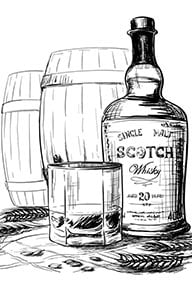Start 14-Day Trial Subscription
*No credit card required

Get To Know Your Whisky From Your Bourbon With These Easy Pointers
It is said that all bourbons are whisky, but not all whiskies are bourbons, so what is the difference, and why would anyone care?
The world of whisky may seem intimidating, but with these pointers, you’ll be able to impress those around you with your worldly knowledge. It is also important to know which brands stand out for quality, therefore referencing trusted sources such as Whisky World reviews will help you make purchasing decisions and provide recommendations to your peers.
Keep reading to find out the difference between these beloved beverages.
Ingredients
Whisky and bourbon may seem similar, but subtle differences set the two apart. Starting from the very beginning before any fermenting or distilling takes place.
Whisky is made up of fermented grains or mash that can include barley, corn, rye and wheat. In contrast, bourbon must be made from at least 51% corn to be considered a bourbon. This corn is what gives bourbon its famed sweet taste.
Whisky can contain water and caramel coloring, but bourbon never contains additives like color or flavor.
Location
Whisky may be synonymous with Scotland and Ireland, but it can be made anywhere in the world. And there are a few varieties to choose from Japanese, Canadian and over 20 countries producing their own whiskies.
It must be made in the United States of America to be considered bourbon. Most famously, though, it originally hails from the South, mostly Kentucky, where most bourbon distillers are located.
Whisky gets its name from Gaelic, uisge beatha and translates to ‘water of life’, and the word ‘bourbon’ comes from old Bourbon, now Bourbon County in Kentucky.
A Barrel of Fun
Barreling is more than just storage. Bourbon and whisky take very different and strict approaches when it comes to storing. The barrels, also referred to as casks, influence the whisky process.
Bourbon must be stored and aged in charred new American oak barrels, and these will not be used for the same purpose again. Every bourbon gets a fresh barrel.
Whiskies, however, are less picky. Whisky barrels do not need to be new; they can be stored in used barrels.
These barrels could have been used to store other spirits; port, sherry, rum and even bourbon barrels can be used in the whisky aging process.
It may not seem like it, but the whisky cask does matter. The cask influences the process and helps to define the taste.
The wood of the cask will provide complex flavors. Ultimately, different barrels impart different flavors. And the more times a cask is used, the less flavor will be imparted.
When it comes to flavoring the size of the cask, a greater surface area to volume ratio and more time spent in the cask will result in more flavor.
Aging Gracefully
Age before beauty, whisky before bourbon? When it comes to whisky and bourbon, there’s no question that whisky is the elder leading the way.
As far back as 1405, whisky has appeared in written records. Bourbon, however, was said to be invented in 1789 by Elijah Craig, fondly known as the father of bourbon, who aged corn whisky in newly charred oak barrels.
There has been some dispute, but bourbon sprung up and made its mark.
The age only refers to the time between distillation and bottling. Surprisingly, aging a bourbon doesn’t require a specified time.
Legally, bourbon can be aged for a day and still be called bourbon. But, most spend four to seven years in the barrel.
Whisky likes to take its time too. Whisky can age anywhere between 3 to 12 years. However, Scottish whisky is required by law to be aged in oak barrels for at least three years.
Scottish and Irish whiskey requires 10 years to develop its high-quality flavor. As the age increases, so does the price tag.
Flavor and Color
No flavor or coloring may be added to bourbon; if any flavor is added, it is no longer classified as bourbon but rather whisky liqueur.
The sweet flavor profile of bourbon consists of vanilla, oak, and caramel notes.
The color of bourbon and whisky comes from aging in its barrel; contact with the wood also adds flavor.
The color of whisky ranges from clear to pitch black; color can also come from caramel agents.
Providing the flavor profile of whisky varies depending on the type of whisky it is, Scottish, Irish, or Japanese, so if you're trying to find your perfect match sign up for a whisky subscription.
Conclusion
Now that you know the differences between these beverages, sign up for a whisky subscription and find what whisky suits you.



